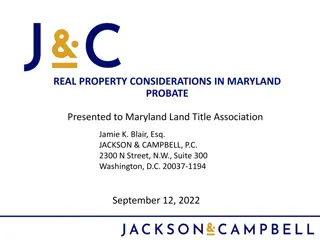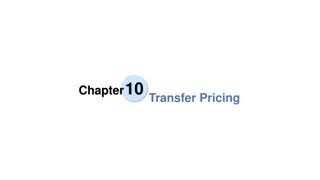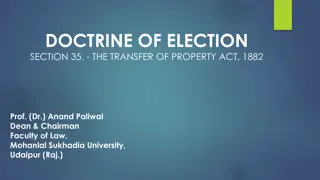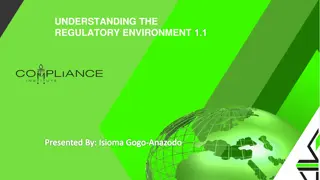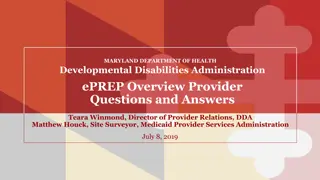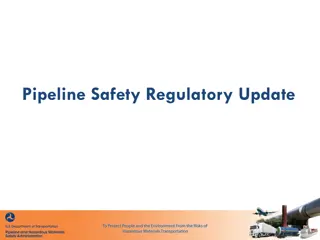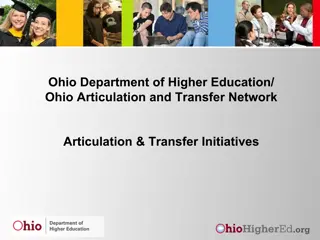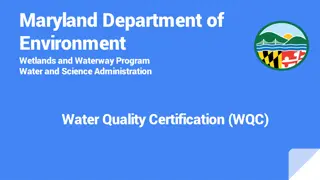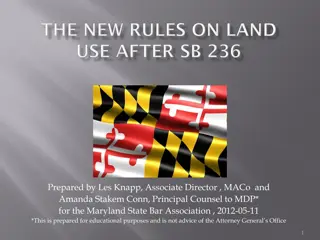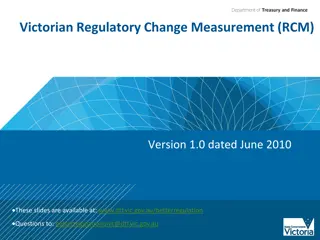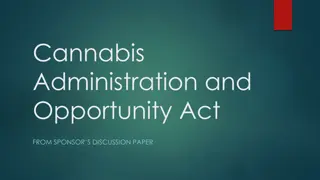Overview of Transfer with Success Act and Regulatory Changes in Maryland
The Transfer with Success Act, passed in 2021, introduced new requirements for public institutions in Maryland related to credit transfers between institutions. Recent stakeholder work groups and regulatory changes have paved the way for implementing these new regulations, aiming to facilitate smoother course equivalency and credit transfer processes. The focus is on maximizing transferability and transparency to enhance collaboration among institutions.
Uploaded on Sep 10, 2024 | 0 Views
Download Presentation

Please find below an Image/Link to download the presentation.
The content on the website is provided AS IS for your information and personal use only. It may not be sold, licensed, or shared on other websites without obtaining consent from the author. Download presentation by click this link. If you encounter any issues during the download, it is possible that the publisher has removed the file from their server.
E N D
Presentation Transcript
An Overview of the An Overview of the Transfer with Success Act and Transfer with Success Act and Regulatory Changes Regulatory Changes Maryland Higher Education Commission November 15, 2023 Emily A. A. Dow, Ph.D., Assistant Secretary of Academic Affairs 1
2 https://app.powerbigov.us/view?r=eyJrIjoiY2I4Y2FlYzUtZDQ4Yi00NjU2LWEyYjYtZmZkNGQ4 MWRlOWIyIiwidCI6IjYwYWZlOWUyLTQ5Y2QtNDliMS04ODUxLTY0ZGYwMjc2YTJlOCJ9
3 Students with Title IV aid and enrolled in community colleges as their first postsecondary institution in 2014; students followed for 8 years. Source: Office of Chief Economist, US Department of Education
Transfer with Success Act Transfer with Success Act (HB460/SB886) Legislation passed in 2021 Created a new requirement for public institutions to jointly review credits or courses that are denied when a student transfers from one public institution to another. Created a new annual reporting requirement: institutions are now obligated to submit to the Commission a report listing all denials over the course of each year, including the reasons for each denial. 4
Recent Work Recent Work 2021-2022: Stakeholder workgroup met regularly to inform regulatory changes Late spring summer 2022: regulations went through AELR process Oct 2022: Guidance was released Jan 2023: Implementation plans received 5
Current Work Current Work Course Equivalency Guidance: document being prepared in consultation with the Faculty Advisory Council Data Collection: Reviewing the initial submissions and developing the guidance for future submissions 6
Statewide Transfer Principles Statewide Transfer Principles Maximizing the Transfer of Courses and Credits Difference between credits and courses Difference between transferability and applicability Transparency Equality Collaboration 7
Evaluation and Review Process 1. Transfer Evaluation Request 2. Evaluation of Course or Credit 3. Transfer Evaluation Report 5. Final Determination 4. Review of Denial 8
Evaluation and Review Process 1. Transfer Evaluation Request 2. Evaluation of Course or Credit 3. Transfer Evaluation Report 5. Final Determination 4. Review of Denial Transfer Evaluation Request by Student Student submits a request The request shall be in the form and manner required by the receiving institution Request shall identify each completed course and each credit awarded for prior learning that the student desires to transfer to the receiving institution. Campuses can create an automatic opt-in or opt-out process 9
Evaluation and Review Process 1. Transfer Evaluation Request 2. Evaluation of Course or Credit 3. Transfer Evaluation Report 5. Final Determination 4. Review of Denial Is it transferable? Is there an articulation agreement, course equivalency list or other institutional publication specific to the course(s)/credits transfer? Does the course/credit fulfill a general education requirement? Is there a course equivalency? Is the credit equivalent for credit for prior learning? If yes to at least one, course is transferable. If no to all, then course or credit is denied for transfer. 10
Evaluation and Review Process 1. Transfer Evaluation Request 2. Evaluation of Course or Credit 3. Transfer Evaluation Report 5. Final Determination 4. Review of Denial Applicability is a different evaluative process from transferability Exception: If more than 70 credits can be transferred, receiving institution should transfer the most valuable courses 11
Evaluation and Review Process 1. Transfer Evaluation Request 2. Evaluation of Course or Credit 3. Transfer Evaluation Report 5. Final Determination 4. Review of Denial What about the grade earned: use the same standard as you would for a non-transfer student Number of credits awarded: cannot be less than what the student earned at the sending institution 12
Evaluation and Review Process 1. Transfer Evaluation Request 2. Evaluation of Course or Credit 3. Transfer Evaluation Report 5. Final Determination 4. Review of Denial -- must be done for both transfer and denied courses -- Transfer Evaluation Report what is included: Transferred Credit the basis for transferability Denied Credit a clear and detailed explanation for the denial a clear and detailed explanation when over 70 credit limit A statement that the sending institution will review, without further action on the part of the student Contact person and information **Goes to both student and sending institution(s).
Evaluation and Review Process 1. Transfer Evaluation Request 2. Evaluation of Course or Credit 3. Transfer Evaluation Report 5. Final Determination 4. Review of Denial Review of Denial Only happens when: There is a denial of transfer AND The sending institution is a public Maryland college or university
Evaluation and Review Process 1. Transfer Evaluation Request 2. Evaluation of Course or Credit 3. Transfer Evaluation Report 5. Final Determination 4. Review of Denial Review of Denial Sending institution shall conduct an analysis Does the sending institution agree or disagree with the receiving institution s evaluation of denial?
Evaluation and Review Process 1. Transfer Evaluation Request 2. Evaluation of Course or Credit 3. Transfer Evaluation Report 5. Final Determination 4. Review of Denial Review of Denial: Meeting Institutions shall meet to discuss the analysis Waiver of meeting can be requested to MHEC by sending institution for good cause Sending institution will either revise the analysis or provide written notification that no revisions are necessary
Evaluation and Review Process 1. Transfer Evaluation Request 2. Evaluation of Course or Credit 3. Transfer Evaluation Report 5. Final Determination 4. Review of Denial Final Determination The receiving institution shall provide to the student: A Revised Transfer Evaluation Report, or Written notification that the review process has not resulted in any changes to the Transfer Evaluation Report. The decision regarding the transferability arising out of the review process constitutes the final decision of the receiving institution and is not subject to appeal.
Course Equivalencies: The New 70% Rule Course Equivalencies: The New 70% Rule A course at a sending institution is deemed equivalent when the receiving institution determines that at least 70 percent of the course learning objectives* are the same for a course at the receiving institution. No other standard or method can be used to determine equivalency (e.g., textbook, assessments) Cannot consider the course numbers or levels to determine equivalency Equivalencies must be determined by faculty who are subject matter experts 18 * Learning objective means a description of the knowledge, skills, competencies, or expertise that a student is expected to obtain, exhibit, or meet upon the successful completion of a specific course or program.
Transfer of Courses & Credits Transfer of Courses & Credits General Education General Education General education courses transfer, no questions asked The transferred course should be applied to the same core area at the receiving institution Transfer should happen regardless of whether an equivalent course exists at receiving institution Each public institution shall designate on the student transcript those courses that have met a general education requirement, including the specific core area (from Gen Ed regulations) 19
Articulation Agreements Articulation Agreements via Academic Program Review via Academic Program Review Academic Program Proposals for undergraduate degrees will be required to include: A proposed articulation agreement, or Proposed revisions to existing articulation agreement(s), or Justification for why an articulation agreement in not feasible or applicable 20
Transfer Coordinators Transfer Coordinators Serves as a resource person to students seeking to transfer courses and credits. Is responsible for coordinating the application of the policies and procedures established. Is responsible for overseeing the process of the evaluation of student transfer requests. Is not responsible for determining course equivalencies or credit for prior learning (that lives with faculty who are subject matter experts). 21
Articulation Agreements Articulation Agreements Program Transfer Agreement an articulation agreement between a receiving institution and a sending institution that sets forth the course and other degree requirements within a single bachelor s degree program offered by the receiving institution that may be completed at the sending institution. Articulation Agreement a written agreement for the awarding of credit by an institution of higher education for the completion of coursework or prior learning at another institution or entity. Prior Learning Transfer Agreement Course Transfer Agreement an articulation agreement for a receiving institution toward academic credit for demonstrated proficiency, a satisfactory score on a specific assessment, applied experience, or other learning experience completed at an institution of postsecondary education or other entity. an articulation agreement regarding the award of credit by a receiving institution for courses completed at the sending institution that are not specific to the completion of an academic program at the receiving institution. 22
Current Work Current Work Course Equivalency Guidance: document being prepared in consultation with the Faculty Advisory Council Data Collection: Reviewing the initial submissions and developing the guidance for future submissions 23


